
Apple Blossom Lamp, Tiffany Studios, ca. 1905. Leaded glass, bronze.
The Newstadt Collection of Glass, Queens, New York
As a painter, Louis C. Tiffany was captivated by the interplay of light and color, and this fascination found its most spectacular expression in his glass “paintings.” Through the medium of opalescent glass, Tiffany could actually capture light in color and manipulate it to achieve impressionistic effects. Using new and innovative techniques and materials, Tiffany Studios created leaded-glass windows and lampshades in vibrant colors and richly varied patterns, textures, and opacities.
Organized by The Neustadt Collection of Tiffany Glass in New York City, Tiffany Glass: Painting with Color and Light is comprised of five windows, twenty lamps, and more than one hundred examples of flat glass and glass "jewels" that illustrate the rich expanse of color and light available to the artists at the Tiffany Studios. The objects on display are some of the most iconic and celebrated of Tiffany’s works. Chosen for their masterful rendering of nature in flowers or landscape scenes and for the subtle use of light and shading in decorative geometric patterns, they exemplify the rich and varied glass palette, sensitive color selection, and intricacy of design that was characteristic of Tiffany’s leaded-glass objects. Accompanying these works of art is an educational model illustrating how leaded-glass shades are fabricated and three examples of Tiffany lamp forgeries to explore issues of authenticity and connoisseurship. This exhibition also highlights some of the key figures at the Tiffany Studios who made essential contributions to the artistry of the windows and lamps: chemist Arthur J. Nash and leading designers Agnes Northrop, Frederick Wilson, and Clara Driscoll.